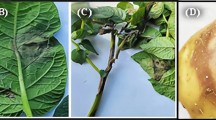Summary
TwoPythium spp. were isolated from diseased tubers exhibiting rots at harvest, in summer stores and also in refrigerated storage. Symptoms shared features described for both pink rot caused byPhytophthora erythroseptica and leak caused byPythium spp.
The causal agents were identified asPythium aphanidermatum andP. ultimum by morphological and physiological observations and by fingerprinting using oomycete specific primers to amplify the internal transcribed spacer (ITS1) within ribosomal DNAs. The optimum temperatures for infection were 30°C forP. aphanidermatum and 25°C forP. ultimum, corresponding to the optimum temperatures for growth in vitro. The optimum concentration for infection of tubers inoculated by dipping in a suspension of oospores or hyphal swellings after wounding was found to be 103 reproductive organs/ml, whereas the infection threshold was 10 reproductive organs/ml.
Similar content being viewed by others
References
Bonnet, P., P. Ricci & S. Mercier, 1980. Le dépérissement du Gerbera causé parPhytophthora cryptogea Pethyb. et Laff. Diagnostic à partir du matériel végétal par isolement et détermination rapide.Annales de Phytopathologie 12: 109–118.
Burr, T.J. & M.E. Stanghellini, 1973. Propagule nature and density ofPythium aphanidermatum in soil.Phytopathology 63: 1499–1501.
Domsch, K.H., W. Gams & T.H. Anderson, 1980.Pythium Pringsheim 1858. In: Compendium of soil fungi. Academic Press, NY, pp. 678–697.
Fernandez-Northcote, E.N., E.Y. Huapaya & H. Torres, 1972. La podredumbre rosada de la papa: bùsqueda de fuentes de resistencia en tubérculos.Fitopatologia 6: 18–27.
Grisham, M.P., R.A. Taber & L.W. Barnes, 1983.Phytophthora rot of potatoes in Texas caused byPhytophthora parasitica andP. cryptogea Plant Disease 67: 1258–1261.
Hendrix, F.F. & W.A. Campbell, 1973.Pythiums as plant pathogens.Annual Review of Phytopathology 11: 77–98.
Lapwood, D.H., P.J. Read & J. Spokes, 1984. Methods for assessing the susceptibility of potato tubers of different cultivars to rotting byErwinia carotovora subsp.atroseptica andcarotovora.Plant Pathology 33: 13–20.
Lennard, J.H., 1980. Factors influencing the development of potato pink rot (Phytophthora erythroseptica).Plant Pathology 29: 80–86.
McCarter, S.M. & R.H. Littrell, 1970. Comparative pathogenicity ofPythium aphanidermatum andPythium myriotylum to twelve plant species and intraspecific variation in virulence.Phytopathology 60: 264–268.
McKenzie, A.R. & C.H. Lawrence, 1981. Leak. In: W.J. Hooker (Ed.), Compendium of potato diseases. American Phytopathological Society, St Paul, MN, pp. 38–39.
Mugnier, J. & M.C. Grosjean, 1995. PCR catalogue in Plant Pathology:Pythium. Société Française de Phytopathologie (Ed.), 89 pp.
Perez, W., L. Gutarra & E. French, 1994.Pythium ultimum Trow. causante de pudricion acuosa en tubérculos de papa en el Peru.Fitopatologia 29: 191–195.
Priou, S. & M. El Mahjoub, 1994. Incidence of bacterial and fungal diseases of potato in Tunisia. Proceedings of the 3rd Triennial Conference of Potato African Association (APA), 9–13 May 1994, Sousse, Tunisia.
Priou, S. & M. El Mahjoub, 1999. Bacterial and fungal diseases in the major potato-growing areas in Tunisia.EPPO Bulletin 29: 167–171.
Rowe, R.C. & A.F. Shmitthenner, 1977. Potato pink rot in Ohio caused byPhytophthora erythroseptica andPhytophthora cryptogea.Plant Disease Reporter 61: 807–810.
Rowe, R.C. & L.W. Nielsen, 1981. Pink rot In: W.J. Hooker (Ed.) Compendium of potato diseases. American Phytopathological Society, St Paul, MN, pp. 39–40.
Stanghellini, M.E. & J.G. Hancock, 1971. The sporangium ofPythium ultimum as a survival structure in soil.Phytopathology 61: 157–164.
Stanghellini, M.E., L.J. Stowel, W.C. Kronland & P. von Bretzel, 1983. Distribution ofPythium aphanidermatum in rhizosphere soil and factors affecting expression of the absolute inoculum potentialPhytopathology 73: 1463–1466.
Van der Plaats-Niterink, A.J., 1981. Monograph of the genusPythium.Studies in Mycology 21: 1–242.
Vargas, L.A. & L.W. Nielsen, 1972.Phytophthora erythroseptica in Peru: its identification and pathogenesis.American Potato Journal 49: 309–320.
Waterhouse, G.M., 1968. The genusPythium. Diagnoses (or descriptions) and Figs from the original papers.Mycological Papers 110: 1–71.
Author information
Authors and Affiliations
Rights and permissions
About this article
Cite this article
Triki, M.A., Priou, S., El Mahjoub, M. et al. Leak syndrome of potato in Tunisia caused byPythium aphanidermatum andPythium ultimum . Potato Res 44, 221–231 (2001). https://doi.org/10.1007/BF02357900
Accepted:
Issue Date:
DOI: https://doi.org/10.1007/BF02357900




